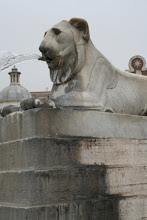Walk around Rome for long enough and you'll start wincing at the architecture of the fascist era. Strictly symmetrical, with a focus on utility of design, these buildings present a no-holds-barred functionality with little decorative value.
Under Mussolini's unified Italy, this modernist style was adopted in the architecture of the 1920's and 1930's, with Rome's Cinema City ("Cinecittà") built to this style in 1937. Originally constructed for propaganda-film purposes, the complex was bombed during the second world war, and following the war Cinecittà became a misplaced-persons camp.
By the 1950's Cinecittà was once again making movies. Legendary classics such as the Fellini films La Dolce Vita and Casanova, the american blockbuster Ben Hur and Zefferelli's Romeo and Juliet were created here. And in more recent years Martin Scorsese's Gangs of New York, and the HBO series Rome were filmed here, too.
Friday at noon we finished our last grammar session for the week and took the Metro line A out to the furthest point on the Anagnina line to visit Cinecittà. Cinecittà lies about 10km south-east of Rome.
We arrived at the studio in time to take a guided tour in italian, with a handful of us standing in the sunlight listening to our guide recount the early years of the complex, the famous movies that were produced by equally-famous directors and how the intricate crafting of movie sets involves construction of massive wooden mounts, covered in tons of polystyrene, gesso and paint. And also, how the internal sets are created, used, dissembled and stored in the giant warehouses that stand on the boundaries of the Cinecittà.
We had a great time walking over the huge Gangs of New York set (now looking even more dilapidated) and the impressive sets of the Forum and Subura of the Rome series. Buildings of imperial Rome are painted in the pompeiian colours of red and ochre, with the "ancient" stones of the forum leading into the jumble of the subura, where the upper-storeys of the houses almost touch each other across narrow alleyways.
Afterwards, we walked though the mostra (exhibition) of sight and sound - a long tunnel-like space is covered in moving images on the floor, ceiling and walls from Cinecittà's epic films - ducking into various smaller rooms to see post-production, costuming and internal movie sets.
We all agreed it was a fantastic experience. Although we found the commentary difficult to follow in rapid, non-school italian, it was another facet of learning the language and great to see another side of the city.
After catching the metro to the San Giovanni stop, we ended our day drinking Sauvignon Blanc from the Fruili region at an enoteca in Monti, before walking back down past the Colosseum and Vittorio Emanuele monument in the early evening.
At the Largo Agentina we said our goodbyes to Karina, who leaves today to fly back to Belgium before Juliana and I resume school again on Monday. Its been great having Karina around and I'm going to miss her. The great thing about being here in Rome, aside from learning the language and enjoying the city, is the fantastic friendships I've made over the past few weeks. We all plan to meet back in Rome in the not-too-distant future.
At the Largo Agentina we said our goodbyes to Karina, who leaves today to fly back to Belgium before Juliana and I resume school again on Monday. Its been great having Karina around and I'm going to miss her. The great thing about being here in Rome, aside from learning the language and enjoying the city, is the fantastic friendships I've made over the past few weeks. We all plan to meet back in Rome in the not-too-distant future.









